A mass for asymptotically complex hyperbolic manifolds
A mass for asymptotically complex hyperbolic manifolds
A mass for asymptotically complex hyperbolic manifolds
Create successful ePaper yourself
Turn your PDF publications into a flip-book with our unique Google optimized e-Paper software.
hal-00429306, version 1 - 2 Nov 2009<br />
2 A MASS FOR ASYMPTOTICALLY COMPLEX HYPERBOLIC MANIFOLDS.<br />
chart at infinity by<br />
(1) µg = − 1<br />
4 lim<br />
<br />
R−→∞<br />
SR<br />
∗(div g + dTr g) ,<br />
where the sphere, Hodge star, the divergence and the trace are defined with respect to<br />
the Euclidean metric gRn at infinity. It is not obvious that this quantity depends only on<br />
g and not on the chart but [Bart] proved it. We refer to [SY1, SY2, Wit, Bart, LP] <strong>for</strong><br />
details and “classical” proofs and to [Loh] <strong>for</strong> a more recent and more general treatment.<br />
The mathematical interest of such a theorem is the rigidity result it involves: under<br />
a nonnegativity assumption on the curvature, it asserts a model metric at infinity<br />
(the Euclidean metric, here) cannot be approached at any rate, the obstruction being<br />
precisely the <strong>mass</strong>. Another striking feature of this theorem is its role as a key step in<br />
the first proof of the Yamabe theorem [LP] ; see also [ST] <strong>for</strong> a nice application of the<br />
positive <strong>mass</strong> theorem to obtain a rigidity result <strong>for</strong> compact <strong>manifolds</strong> with boundary.<br />
It is possible to extend these ideas behind this theorem in several contexts, involving<br />
different models at infinity. The authors of [MO, AD, CH] studied the case of <strong>manifolds</strong><br />
whose model at infinity is the real <strong>hyperbolic</strong> space RHn . More sophisticated models<br />
are also considered in [Dai, Min]. The notion of real <strong>hyperbolic</strong> <strong>mass</strong> introduced in<br />
[CH] is at the very root of our work so we need to explain what it looks like (note it<br />
is more general than what follows). Basically, while the Euclidean <strong>mass</strong> (1) is a single<br />
number, the real <strong>hyperbolic</strong> <strong>mass</strong> appears naturally as a linear functional on some finite<br />
dimensional vector space N, attached to the model at infinity, RHn . More precisely,<br />
[CH] defines N as the set of functions u on RHn such that HessRHn u = ugRHn and<br />
the <strong>mass</strong> linear functional is given by<br />
(2)<br />
µg(u) = − 1<br />
4 lim<br />
<br />
∗[(div g + dTr g) u − Tr(g − gRHn)du + (g − gRHn)(grad u,.)] ,<br />
R−→∞<br />
SR<br />
where the right-hand side is computed with respect to the real <strong>hyperbolic</strong> metric gRH n<br />
at infinity. It turns out that N can be interpreted as the set of parallel sections <strong>for</strong><br />
some natural vector bundle E, endowed with a natural connection ∇ RH preserving a<br />
natural Lorentz metric h : if you see RH n as a hypersurface in Minkowski space R n,1 ,<br />
then (E,h) is simply the restriction of the tangent bundle TR n,1 and ∇ RH is induced by<br />
the flat connection on Minkowki space ; from this point of view, N identifies naturally<br />
with R n,1 . We will give more details on this picture in the first section of this text<br />
and explain why it is natural that the <strong>mass</strong> belongs to the dual of this space N and<br />
why the <strong>for</strong>mula above is a relevant geometric invariant. The basic idea is that any<br />
Riemannian manifold carries a natural connection ∇ RH that is flat iff the manifold is<br />
(locally) <strong>hyperbolic</strong> ; the <strong>mass</strong> appears naturally as an obstruction to the construction<br />
of parallel sections <strong>for</strong> this connection.<br />
The model at infinity we wish to consider is the <strong>complex</strong> <strong>hyperbolic</strong> space CH m ,<br />
which is a counterpart of the real <strong>hyperbolic</strong> space RH n in <strong>complex</strong> geometry. Up to<br />
scale, it is indeed the unique simply-connected complete Kähler manifold with constant<br />
holomorphic sectional curvature. To be concrete, let us recall that CH m can be seen<br />
as the unit ball in C m , endowed with its standard <strong>complex</strong> structure J and with the<br />
Kähler metric<br />
gCHm = gCHm =<br />
1<br />
(1 − s2 ) 2<br />
2 2 2 2<br />
ds + (Jds) + s (1 − s )gFS ,


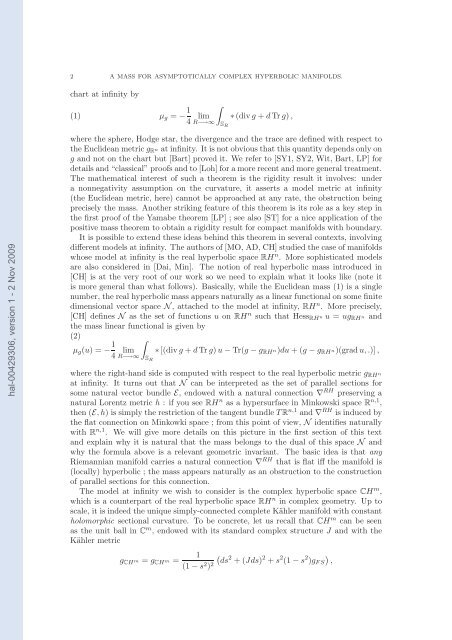

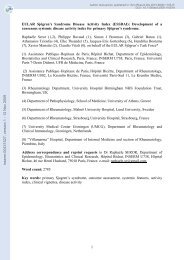
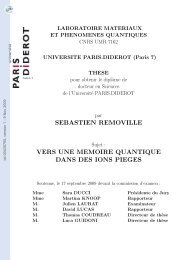
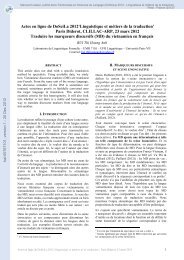
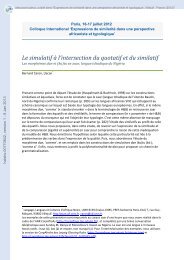
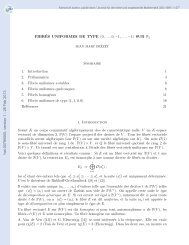
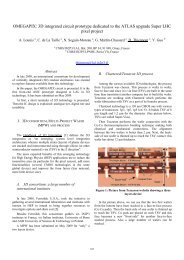
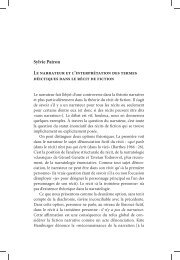
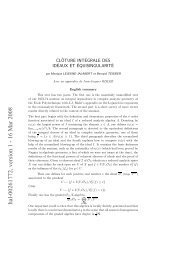
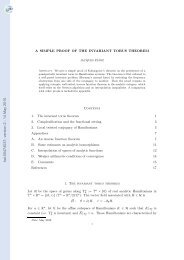

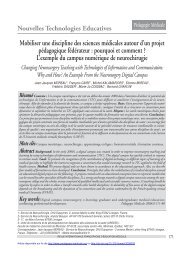

![[tel-00433556, v1] Relation entre Stress Oxydant et Homéostasie ...](https://img.yumpu.com/19233319/1/184x260/tel-00433556-v1-relation-entre-stress-oxydant-et-homeostasie-.jpg?quality=85)